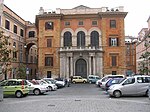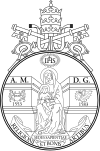Forum Suarium
Ancient Roman building and structure stubsFora venalia of Rome
The Forum Suarium was the pork forum venalium of ancient Rome during the empire, mentioned first in two inscriptions dating c. AD 200. This market was near the barracks of the cohortes urbanae in the northern part of the Campus Martius, probably close to the present Via di Propaganda, and its administration was in the hands of the prefect or of one of his officers.
Excerpt from the Wikipedia article Forum Suarium (License: CC BY-SA 3.0, Authors).Forum Suarium
Vicolo del Monticello, Rome Municipio Roma I
Geographical coordinates (GPS) Address Nearby Places Show on map
Geographical coordinates (GPS)
| Latitude | Longitude |
|---|---|
| N 41.8992 ° | E 12.4839 ° |
Address
Palazzo Frascara
Vicolo del Monticello
00187 Rome, Municipio Roma I
Lazio, Italy
Open on Google Maps










